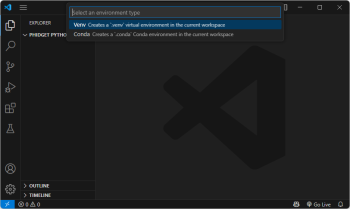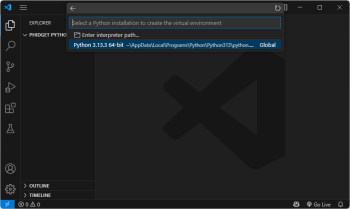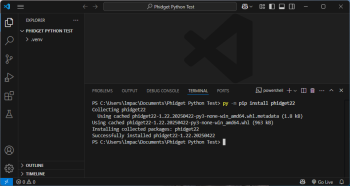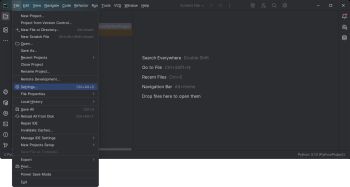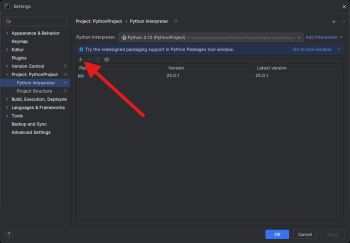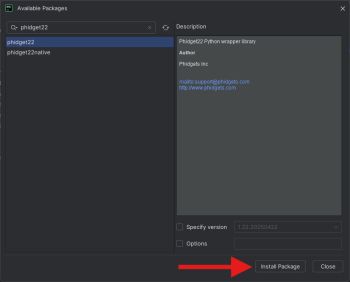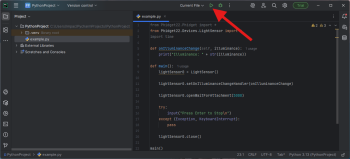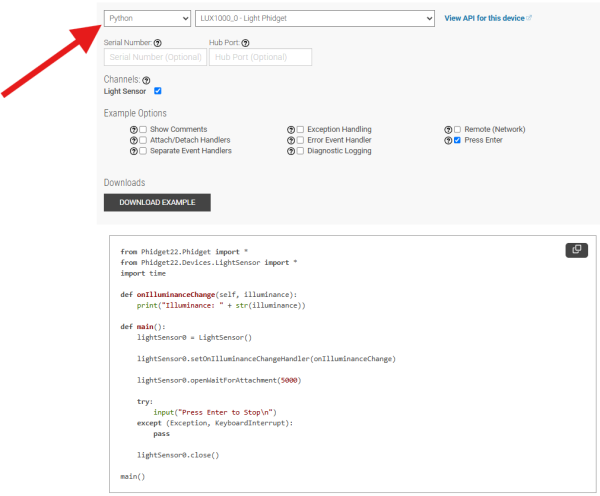|
|
| (200 intermediate revisions by 9 users not shown) |
| Line 1: |
Line 1: |
| | {{#seo:|description=Learn how to use Phidget USB devices with Python.}} |
| [[Category:Language]] | | [[Category:Language]] |
| [[File:icon-Python.png|64x64px|link=|alt=Python]] Python is an object oriented programming language developed by the [http://www.python.org/psf/summary/ Python Software Foundation], is powerful and easy to learn.
| |
|
| |
|
| __TOC__
| | ==Get Started== |
| | With the Phidget22 Python library, it's easy to create Python applications that work with Phidget devices. |
|
| |
|
| ==Introduction== | | ==Python Libraries== |
| | ===pip Package=== |
| | The Phidget22 Python library is available as a [https://pypi.org/project/phidget22/ pip package]. Most development environments provide built-in tools to manage packages. View the [[#Development Environment Configuration | Development Environment Configuration]] section below for examples. |
|
| |
|
| {{LanguageSupport|Python|the complete Phidget API, including events|all Phidget devices.|Windows, Mac OS X and Linux. We provide instructions on how to set up your environment/compilers for [[#Visual Studio 2005/2008/2010 | Visual Studio 2005/2008/2010]], [[#Visual Studio 2003 | Visual Studio 2003]], [[#MonoDevelop | MonoDevelop]] and the [[#Mono | Mono command line compilers]]|}}
| | ====macOS Considerations==== |
| | Phidget devices running a HID USB stack require the installation of the macOS libraries or the standalone Phidget Control Panel ([{{SERVER}}/docs/OS_-_macOS download here]). |
|
| |
|
| ==Quick Downloads==
| | To determine what USB stack your Phidget device is on, navigate to the product page and then to the specification tab, and look for the ''USB Stack'' specification. If you are using a VINT device, navigate to the product page for the VINT Hub you are using. |
|
| |
|
| Just need the Python documentation, drivers, libraries, and examples? Here they are:
| | [[Image:Javascript_networkserver_webusb_spec.png|center|600px|link=https://cdn.phidgets.com/docs/images/8/80/Javascript_networkserver_webusb_spec.png]] |
|
| |
|
| API Documentation:
| | ====Linux Considerations==== |
| *[http://www.phidgets.com/documentation/PythonDoc.zip API Manual]
| | Linux restricts access to USB devices to the root user. To run your Python application as a regular user, you'll need to [{{SERVER}}/docs/OS_-_Linux#Setting_Udev_Rules set up udev rules] on your system. |
|
| |
|
| Example Code:
| | ===Source Files=== |
| | The Phidget22 Python library source files are available [https://cdn.phidgets.com/downloads/phidget22/libraries/any/Phidget22Python.zip here]. |
|
| |
|
| *[http://www.phidgets.com/downloads/examples/Python_2.1.8.20120131.zip Example Code]
| | ==Development Environment Configuration== |
| | Most development environments provide built-in tools to manage Python interpreters, packages, and virtual environments. See the examples below for more information. |
| | ===Installing a Python Interpreter=== |
| | If you don't already have a Python interpreter installed, you can download and install one from [https://www.python.org/downloads/ python.org] or through package managers like [https://brew.sh/ Homebrew]. |
|
| |
|
| Libraries and Drivers:
| | ===Visual Studio Code=== |
| *[http://www.phidgets.com/downloads/libraries/PhidgetsPython_2.1.8.20120131.zip Python Library]
| | {| style="margin:auto;" class="table-no-border mw-collapsible mw-collapsed" |
| *[http://www.phidgets.com/downloads/libraries/Phidget-x86_2.1.8.20111220.exe 32-bit Windows Drivers Installer]
| | |+ '''Instructions''' |
| *[http://www.phidgets.com/downloads/libraries/Phidget-x64_2.1.8.20111220.exe 64-bit Windows Drivers Installer]
| | | Install the [https://marketplace.visualstudio.com/items?itemName=ms-python.python Python extension for Visual Studio Code].|| [[Image:Language_python_vscode_install.png|center|350px|link=https://cdn.phidgets.com/docs/images/f/f9/Language_python_vscode_install.png]] |
| *[http://www.phidgets.com/downloads/libraries/libphidget_2.1.8.20111028.tar.gz Linux Source]
| | |- |
| *[http://www.phidgets.com/downloads/libraries/Phidget_2.1.8.20111103.dmg General Mac OS X Drivers Installer]
| | | Next, create a directory and open it in Visual Studio Code. You can do this by opening Visual Studio Code and selecting '''File > Open Folder...''' || [[Image:Language_python_vscode_newfolder.png|center|350px|link=https://cdn.phidgets.com/docs/images/f/f8/Language_python_vscode_newfolder.png]] |
| | | |- |
| ==Getting started with Python==
| | | Open the Command Palette (Ctrl + Shift + P), type '''Python: Create Environment''', and press Enter. Select '''Venv''' when prompted. || [[Image:Language_python_vscode_newvenv.png|center|350px|link=https://cdn.phidgets.com/docs/images/a/a6/Language_python_vscode_newvenv.png]] |
| | | |- |
| If you are new to writing code for Phidgets, we recommend starting by running, then modifying existing examples. This will allow you to:
| | | Next, select your preferred Python interpreter from the list. You may need to browse to find it. || [[Image:Language_python_vscode_selectinterpreter.png|center|350px|link=https://cdn.phidgets.com/docs/images/2/20/Language_python_vscode_selectinterpreter.png]] |
| {{ExampleCodeReasons}}
| | |- |
| | | | Open a new terminal. You can do this through the Command Palette again (Ctrl + Shift + P), by typing '''Terminal: Create New Terminal'''. Install the Phidget22 pip package: |
| Instructions are divided up by operating system. Choose:
| |
| *[[#Windows(2000/XP/Vista/7)|Windows 2000 / XP / Vista / 7]]
| |
| *[[#Mac OS X |Mac OS X]]
| |
| *[[#Linux | Linux]] (including PhidgetSBC)
| |
| | |
| ==Windows(2000/XP/Vista/7)==
| |
| | |
| ===Description of Library===
| |
| C# programs on Windows depend on the following files, which the installers above put onto your system:
| |
| * <b>{{Code|phidget21.dll}}</b> contains the actual Phidgets library, which is used at run-time. By default, it is placed in {{Code|C:\Windows\System32}}.
| |
| You will also need one of the following two files, depending on the .NET framework version you are targeting: | |
| * <b>{{Code|Phidgets Python Module}}</b> is the Phidgets library for Python <i><b>2.5</b></i> or higher. Your compiler has to know where this file is.
| |
| | |
| If you do not want to use our installer, you can download the five [http://www.phidgets.com/downloads/libraries/Phidget21-windevel_2.1.8.20111220.zip file files].
| |
| | |
| | |
| Running the examples and writing your own code can be fairly compiler-specific, so we include instructions for each compiler below.
| |
| | |
| ===IDLE=== | |
| | |
| =====Use Our Examples=====
| |
| | |
| Please start by downloading the [http://www.phidgets.com/downloads/examples/Python_2.1.8.20120131.zip examples] and unpack them into a foler. While these examples were written in Python 3.0, they are also compatible with Python and 2.5 and 2.6.
| |
| | |
| If you aren't sure what the software example for your device is called, check the software object listed in the [[Device List | Getting Started guide for your device]]. Open the example in the IDLE editor
| |
| | |
| The only thing left to do is to run the examples! Click on Run → Run Module
| |
| | |
| [[File:Python IDLE Run.PNG|link=|alt=Run]]
| |
| | |
| Once you have the Python examples running, we have a [[#Follow The Examples|teaching]] section below to help you follow them.
| |
| | |
| =====Write Your Own Code=====
| |
| | |
| When you are building a project from scratch, or adding Phidget function calls to an existing project, you'll need to configure your environment to properly link the Phidget C# libraries. To begin:
| |
| | |
| 1. Generate a new Visual C# Windows Applications project with a descriptive name such as PhidgetTest.
| |
| | |
| [[File:CSharp VS2005 New Project.PNG|link=|alt=New Project]]
| |
| | |
| 2. Add a reference to the .NET Phidgets library.
| |
| | |
| [[File:CSharp VS2005 Add Reference.PNG|link=|alt=Add Reference]] | |
| | |
| 3. Under the .NET tab, select {{Code|Phidget21.NET.dll}}.
| |
| If you used our installer, these files are installed in {{Code|C:\Program Files\Phidgets}}, by default. If it does not appear in this list, then you can browse to the Phidget Framework installation directory and add the file.
| |
| | |
| [[File:CSharp VS2005 Add Reference 2.PNG|link=|alt=Add Reference]]
| |
| | |
| 4. Then, in your code, you will need to include the Phidget library:
| |
| | |
| <div class="source">
| |
| <syntaxhighlight lang=csharp>
| |
| using Phidgets;
| |
| using Phidgets.Events;
| |
| </syntaxhighlight>
| |
| </div>
| |
| | |
| | |
| The project now has access to the Phidget21 function calls and you are ready to begin coding.
| |
| | |
| The same [[#Follow The Examples|teaching ]] section which describes the examples also has further resources for programming your Phidget.
| |
| | |
| ===Visual Studio 2003===
| |
| | |
| =====Use Our Examples=====
| |
| | |
| 1. Download the [http://www.phidgets.com/downloads/examples/CSharp_2.1.8.20110615.zip examples] and unpack them into a folder. Here, you can find example programs for all the devices. If you are not sure what the software example for your device is called, check the software object listed in the [[Device List | Getting Started guide for your device]]. As the examples were written in newer versions of Visual Studio, Visual Studio 2003 is not able to open the examples. Fortunately, you can import the simple examples to a Visual Studio 2003 project. It will be difficult to import the full examples as you will need to recreate the GUI components. In the [[#Use Our Examples 2 | Use Our Examples]] section, it will be assumed that the simple examples are used. You will need this example source code to be copied into your C# project later on.
| |
| | |
| 2. Next, a new project will need to be created. Generate a new Visual C# console application project with a descriptive name such as PhidgetTest.
| |
| | |
| [[File:CSharp_VS2003 New Project.PNG|link=|alt=New Project]]
| |
| | |
| 3. Add a reference to the .NET Phidgets library.
| |
| | |
| [[File:CSharp_VS2003 Add Reference 1.PNG|link=|alt=Add Reference]] | |
| | |
| 4. Under the .NET tab, select {{Code|Phidget21.NET1.1.dll}}. If you used our installer, by default, this file is placed in {{Code|C:\Program Files\Phidgets}}. If it is in another location, please change the path to the file's location accordingly.
| |
| | |
| [[File:CSharp_VS2003 Add Reference 2.PNG|link=|alt=Add Reference]]
| |
| | |
| 5. To import the simple example program into your project, please: open up {{Code|Class1.cs}}.
| |
| | |
| 6. Traverse to the example in Windows Explorer and locate the {{Code|Program.cs}} file.
| |
| | |
| [[File:CSharp VS2003 Source Code.PNG|link=|alt=Source Code]]
| |
| | |
| 7. Copy and paste the contents from that file into {{Code|Class1.cs}}.
| |
| | |
| 8. Comment out the following line as it is not supported in .NET 1.1:
| |
| <div class="source">
| |
| <syntaxhighlight lang=csharp>
| |
| using System.Collections.Generic;
| |
| </syntaxhighlight>
| |
| </div>
| |
| | |
| [[File:CSharp VS2003 Source Code 2.PNG|link=|alt=Source Code]]
| |
| | |
| 9. Then, in your code, you will need to include the Phidget library:
| |
| <div class="source">
| |
| <syntaxhighlight lang=csharp>
| |
| using Phidgets;
| |
| using Phidgets.Events;
| |
| </syntaxhighlight>
| |
| </div>
| |
| | |
| 10. Now, you can run the example. Click on Debug → Start.
| |
| | |
| [[File:CSharp VS2003 Run.PNG|link=|alt=Run]]
| |
| | |
| Once you have the C# examples running, we have a [[#Follow The Examples|teaching ]] section below to help you follow them.
| |
| | |
| =====Write Your Own Code=====
| |
| | |
| When you are building a project from scratch, or adding Phidget function calls to an existing project, you'll need to configure your development environment to properly link the Phidget C# libraries. Please see the [[#Use Our Examples 2 | Use Our Examples ]] section for instructions.
| |
| | |
| ===Mono===
| |
| | |
| This section will provide instructions on how to compile using the {{Code|mcs}} compiler. Other compilers such as {{Code|gmcs}}, {{Code|smcs}}, and {{Code|dmcs}} all work in the same way. Start by downloading the C# Examples.
| |
| | |
| =====Use Our Examples=====
| |
| | |
| Download the [http://www.phidgets.com/downloads/examples/CSharp_2.1.8.20110615.zip examples] and unpack them into a folder. Here, you can find example programs for all the devices. If you aren't sure what the software example for your device is called, check the software object listed in the [[Device List | Getting Started guide for your device]]. Please only use the simple examples. The full examples uses Windows Forms, which Mono and the Gtk# toolkit are not completely compatible with. Locate the {{Code|Program.cs}} file as this contains the example source code. Copy the file into your working directory, and rename it to {{Code|example.cs}}.
| |
| <br/>
| |
| | |
| To compile and build an executable, run:
| |
| <div class="source">
| |
| <syntaxhighlight lang=bash> | | <syntaxhighlight lang=bash> |
| mcs /out:example.exe /lib:"C:\Program Files\Phidgets" /r:phidget21.NET.dll example.cs
| | #Windows |
| </syntaxhighlight>
| | py -m pip install phidget22 |
| </div>
| |
| | |
| If you have the {{Code|Phidget21.NET.dll}} installed in another location, please change the path to the file's location accordingly.
| |
| | |
| Afterwards, you will have an executable named {{Code|example.exe}} that you can run. Place the {{Code|Phidget21.NET.dll}} in the same directory as the executable and type the following to run the program:
| |
| <div class="source">
| |
| <syntaxhighlight lang=bash>
| |
| mono example.exe
| |
| </syntaxhighlight>
| |
| </div>
| |
| | |
| Once you have the C# examples running, we have a [[#Follow The Examples|teaching]] section below to help you follow them.
| |
| | |
| =====Write Your Own Code=====
| |
| | |
| When you are building a project from scratch, or adding Phidget function calls to an existing project, you'll need to configure your development environment to properly link the Phidget C# libraries. Please see the [[#Use Our Examples 3 | Use Our Example ]] section for instructions.
| |
| | |
| In your code, you will need to include the Phidget library:
| |
| | |
| <div class="source">
| |
| <syntaxhighlight lang=csharp>
| |
| using Phidgets;
| |
| using Phidgets.Events;
| |
| </syntaxhighlight>
| |
| </div>
| |
| | |
| | |
| The project now has access to the Phidget21 function calls and you are ready to begin coding.
| |
| | |
| The same [[#Follow The Examples|teaching]] section which describes the examples also has further resources for programming your Phidget.
| |
| | |
| ===MonoDevelop===
| |
| | |
| =====Use Our Examples=====
| |
| | |
| Download the [http://www.phidgets.com/downloads/examples/CSharp_2.1.8.20110615.zip examples] and unpack them into a folder. Here, you can find example programs for all the devices. These examples were written in Visual Studio 2005 and 2008, but are also compatible with MonoDevelop.
| |
| | |
| To load all projects in MonoDevelop, go to File → Open, and open {{Code|AllExamples/AllExamples.sln}}
| |
| | |
| This will load all of the examples available for C#, and then you can set your main project to be the one that matches your device. If you aren't sure what the software example for your device is called, check the software object listed in the [[Device List | Getting Started guide for your device]]. If you are running under the .NET framework, you can use either the full or simple examples. Otherwise, if you are running under the Mono framework, please only use the simple examples. The full examples uses Windows Forms, which is not completely compatible with Mono's Gtk#.
| |
| | |
| [[File:CSharp MonoDevelop Win Start Up.PNG|link=|alt=Start Up Project]]
| |
| | |
| The only thing left to do is to run the examples! Right click the project, and click on {{Code|Run With}} and select the target framework. Please note that the projects, by default try to find the {{Code|Phidget21.NET.dll}} in the {{Code|C\Program Files\Phidgets}}. If you have it installed in another location, please change the path to the file's location accordingly. If you are receiving an error message regarding that the namespace Phidgets cannot be found, please re-add the reference to {{Code|Phidget21.NET.dll}}. Please see the [[#Write Your Own Code 4 | Write Your Own Code]] section for details.
| |
|
| |
|
| [[File:CSharp MonoDevelop Win Run As.PNG|link=|alt=Run As]]
| | #macOS |
| | python3 -m pip install phidget22 |
|
| |
|
| Once you have the C# examples running, we have a [[#Follow The Examples|teaching]] section below to help you follow them.
| | #Linux (Debian) |
| | | python3 -m pip install phidget22 |
| =====Write Your Own Code=====
| |
| | |
| When you are building a project from scratch, or adding Phidget function calls to an existing project, you'll need to configure your development environment to properly link the Phidget C# libraries. To begin:
| |
| | |
| 1. Create a new C# empty project with a descriptive name such as PhidgetTest.
| |
| | |
| [[File:CSharp MonoDevelop Win New Project.PNG|link=|alt=New Project]]
| |
| | |
| 2. Add a reference to the .NET library.
| |
| | |
| [[File:CSharp MonoDevelop Win Reference.PNG|link=|alt=Add Reference]]
| |
| | |
| 3. Select {{Code|Phidget21.NET.dll}}. If you used our installer, by default, this file is placed in {{Code|C:\Program Files\Phidgets}}. If it is in another location, please change the path to the file's location accordingly.
| |
| | |
| [[File:CSharp MonoDevelop Win Reference 2.PNG|link=|alt=Add Reference]]
| |
| | |
| 4. Then, in your code, you will need to include the Phidget library:
| |
| | |
| <div class="source">
| |
| <syntaxhighlight lang=csharp>
| |
| using Phidgets;
| |
| using Phidgets.Events;
| |
| </syntaxhighlight> | | </syntaxhighlight> |
| </div>
| | || [[Image:Language_python_vscode_installpackage.png|center|350px|link=https://cdn.phidgets.com/docs/images/a/a8/Language_python_vscode_installpackage.png]] |
| | | |- |
| The project now has access to the Phidget21 function calls and you are ready to begin coding.
| | | Finally, add your Python file and run it using the button in the top right corner.|| [[Image:Language_python_vscode_runcode.png|center|350px|link=https://cdn.phidgets.com/docs/images/9/96/Language_python_vscode_runcode.png]] |
| | | |- |
| The same [[#Follow The Examples|teaching]] section which describes the examples also has further resources for programming your Phidget.
| | |} |
| | |
| ==Mac OS X== | |
| | |
| Python has excellent support on Mac OS X.
| |
| | |
| The first step in using Python on Mac is to install the Phidget libraries. Compile and install them as explained on the [[Device List|getting started guide for your device]]. Then, the [[OS - Mac OS X]] page also describes the different Phidget files, their installed locations, and their roles....
| |
| | |
| ==Linux==
| |
| | |
| Python has support on Linux.
| |
| | |
| The first step in using Python on Linux is to install the Phidget libraries. Compile and install them as explained on the main [[OS - Linux | Linux page]]. That Linux page also describes the different Phidget files, their installed locations, and their roles.
| |
| | |
| ==Follow The Examples==
| |
| | |
| By following the instructions for your operating system and compiler above, you probably now have a working example and want to understand it better so you can change it to do what you want. This teaching section has resources for you to learn from the examples and write your own.
| |
| | |
| Next, comes our API information. These resources outline the Python Phidget functions:
| |
| | |
| {{UsingAPhidgetInCodeGeneral|both of which are available in Python|[http://www.phidgets.com/documentation/PythonDoc.zip Python API]}}
| |
|
| |
|
| ===Example Flow=== | | ===PyCharm=== |
| | {| style="margin:auto;" class="table-no-border mw-collapsible mw-collapsed" |
| | |+ '''Instructions''' |
| | | Create your PyCharm project and navigate to '''Settings''': || [[Image:Windows_pycharm_settings.jpg|center|350px|link=https://cdn.phidgets.com/docs/images/7/75/Windows_pycharm_settings.jpg]] |
| | |- |
| | | Next, navigate to '''Project > Project Interpreter''' and click on the '''+''' symbol: || [[Image:Windows_pycharm_addpackage.jpg|center|350px|link=https://cdn.phidgets.com/docs/images/6/6f/Windows_pycharm_addpackage.jpg]] |
| | |- |
| | | Search for '''phidget22''' and install the package: || [[Image:Windows_pycharm_installpackage.jpg|center|350px|link=https://cdn.phidgets.com/docs/images/a/ad/Windows_pycharm_installpackage.jpg]] |
| | |- |
| | | Finally, add your Python file and run it using the button at the top of the screen: || [[Image:Windows_pycharm_run.png|center|350px|link=https://cdn.phidgets.com/docs/images/0/0a/Windows_pycharm_run.png]] |
| | |} |
|
| |
|
| {{ExamplePseudocode|In Python, you can name these '''event''' functions whatever you like. You will then pass them as function pointers to the Phidget library below in the Main Code section. This hooks them into the actual events when they occur. <br>
| | ==Example Code== |
| In the example code, the event functions common to all Phidgets are called things like '''AttachHandler()''' and '''DetachHandler()''', etc.<br><br>
| | Navigate to our [https://www.phidgets.com/?view=code_samples&lang=Python Code Sample Generator] to view and download code samples that are tailored to your specific device. |
| Some event functions will be specific to each device, like when a tag is read on an RFID board, or when a sensor value changes on an Interface Kit.
| |
| Other functions are given in the examples to show you more detail on using your Phidget. For example, '''DeviceInitialize()''' will show what needs to be set up for your Phidget before using it.
| |
| |Creating a Phidget software object in Python is specific to the Phidget. For a Phidget Spatial, for example, this would involve creating a {{Code|Spatial}} object. The examples show how to do this and other API functions.<br><br>
| |
| The object provides device specific methods and properties which are available from the API for your specific Phidget.|
| |
| [http://www.phidgets.com/documentation/PythonDoc.zip Python API]}} | |
|
| |
|
| ==Code Snippets== | | [[Image:Language_python_codesample.png|center|600px|link=https://cdn.phidgets.com/docs/images/2/2d/Language_python_codesample.png]] |
|
| |
|
| ==Common Problems and Solutions/Workarounds== | | ===Phidget Programming Basics=== |
| | {{PhidgetProgrammingBasicsLink}} |
|
| |
|
| Here you can put various frequent problems and our recommended solutions.
| | ==API== |
| | [{{SERVER}}/?view=api&lang=Python Phidget22 API] |




